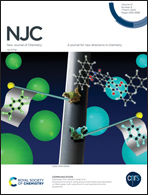Two-step synthesis of a-NiCu(OH)2CO3/Na3NiCuCO3PO4: a battery-type electrode for pseudocapacitor applications†
Abstract
Here, we report the environmentally friendly and cost-effective two-step synthesis of amorphous nickel–copper carbonate hydroxide on nickel–copper carbonophosphate (a-NiCu(OH)2CO3/Na3NiCuCO3PO4) using the alkaline (1 M KOH) etching of hydrothermally prepared Na3NiCuCO3PO4 at room temperature. The KOH etching creates a mesoporous structure, and the high specific surface area (171.14 m2 g−1) assists electrolytes in passing through the porous architecture more efficiently and facilitates high faradaic reactions. The KOH etched sample with a Ni : Cu ratio of 4 : 1 in the precursor (Ni:Cu-80:20+KOH) exhibits excellent specific discharge capacitance of 3400.0 F g−1 at a current density of 1 A g−1. The assembled Ni:Cu-80:20+KOH based symmetric battery-type pseudocapacitor (with 1 mg mass loading) exhibits a maximum energy density of 32.4 W h kg−1 at a power density of 1.54 kW kg−1 with excellent cyclic stability (65% retention after 40 000 charge–discharge cycles at the current density of 5 A g−1). The symmetric supercapacitors (with 4 mg mass loading) connected in series can illuminate a red light-emitting diode (LED) for 18.16 min (two cells) and power a 6 V DC motor fan for 14 s (four cells). The features efficaciously illustrate that a-NiCu(OH)2CO3/Na3NiCuCO3PO4 is a promising electrode material for advance electronic applications.



 Please wait while we load your content...
Please wait while we load your content...